The Wright brothers:
Wilbur and Orville Wright
![[Portrait photo of Wilbur Wright]](http://www.wright-house.com/wright-brothers/wrights/photos/Wilbur_Portrait200.JPEG) The Wright brothers, Orville and Wilbur Wright, had two older brothers,
Reuchlin
(1861-1920) and Lorin (1862-1939), and a younger sister Katharine
(1874-1929). They were the children of Bishop Milton Wright (1828-1917)
and Susan Catherine (Koerner) Wright (1831-1889). Wilbur Wright was born
near Millville, Indiana on April 16, 1867. Orville Wright was born at
7 Hawthorn Street in Dayton, Ohio, August 19, 1871.
The Wright brothers, Orville and Wilbur Wright, had two older brothers,
Reuchlin
(1861-1920) and Lorin (1862-1939), and a younger sister Katharine
(1874-1929). They were the children of Bishop Milton Wright (1828-1917)
and Susan Catherine (Koerner) Wright (1831-1889). Wilbur Wright was born
near Millville, Indiana on April 16, 1867. Orville Wright was born at
7 Hawthorn Street in Dayton, Ohio, August 19, 1871.
Their father settled the family in Dayton, where he was editor of a
newspaper published by the Church of the United Brethren in Christ. His
various jobs as a minister in that church led to the family moving
frequently, but they didn't sell the house on 7 Hawthorn Street, and
kept returning.
The Wright house provided an excellent setting for the children's
intellectual and creative development. Orville wrote of his childhood:
"We were lucky enough to grow up in an environment where there was
always much encouragement to children to pursue intellectual interests;
to investigate whatever aroused curiosity."
One activity Bishop Wright initiated was for debates in which two family
members would each defend one side, then switch and defend the other
side. The house had two libraries: Books on theology in the bishop's
study, while the downstairs library had a large and diverse collection.
Reading in the family library played a big role in the development of
the Wright brothers' interest in flight.
In 1878, when Orville and Wilbur were ages 7 and 11, their father
brought them a toy "helicopter." It was based on an invention by French
aeronautical pioneer Alphonse Penaud. Made of cork, bamboo, and paper,
with a rubber band to twirl its twin blades, it was a little bigger than
an adult's hand. They later said this sparked their interest in flight.
During the next few years, Wilbur and Orville tried to build these
themselves, but the bigger they made them the less well they flew.
Somewhat discouraged, the brothers turned to kites.
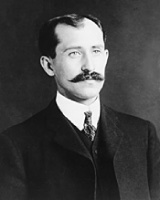 The family moved from Richmond, Indiana back to Dayton in June 1884,
less than a month before Wilbur would have graduated from high school.
The next year he attended Central High School in Dayton for additional
studies, in Greek and trigonometry.
The family moved from Richmond, Indiana back to Dayton in June 1884,
less than a month before Wilbur would have graduated from high school.
The next year he attended Central High School in Dayton for additional
studies, in Greek and trigonometry.
During the winter of 1885-1886, Wilbur was hit in the face
with a hockey stick while playing an ice-skating game, resulting in his
losing his front teeth. The injury did not seem particularly serious,
at least at first. But Wilbur, who had been athletic and healthy until
then, began to be withdrawn. As the Bishop later said,
"In his nineteenth year when playing
a game on skates at an artificial lake at the Soldier's Home near
Dayton,
Ohio, a bat accidentally flew out of the hand of a young man... and
struck
Wilbur, knocking him down, but not injuring him much. A few weeks
later, he
began to be affected with nervous palpitations of the heart, which
precluded
the realization of the former idea of his parents, of giving him a
course in
Yale College." Wilbur remained homebound for the next four years,
possibly suffering as much from depression as from his vaguely-defined
heart
disorder. Wilbur cared for his mother Susan during this time, who was
dying from tuberculosis. He also read extensively from the family
library.
In 1889, with Wilbur's help, Orville designed and built a printing
press, and the brothers began publishing a weekly and then a daily
paper. In 1892 they opened a bicycle shop, and in 1896 started
manufacturing their own brand. Orville invented a self-oiling wheel hub.
That year German aviator Otto Lilienthal died in a glider crash, but
his pioneering work showed that manned flight was feasible. French
aviation researcher Octave Chanute collected data and brought together
young aviators to experiment with gliders on the sand dunes at the Lake
Michigan shore. The Wright brothers interest in flight was renewed, and
they set about to learn everything they could about the subject,
gathering and reading whatever they could, and later designing
experiments of their own.
To provide adequate lift for large gliders, the Wright brothers
needed to find a place with more wind than was typical anywhere near
Dayton. In November 1899, Wilbur wrote to Willis L. Moore, Chief of the
U.S. Weather Bureau, asking about high wind conditions throughout the
country. The first rural place on the list Moore sent back was Kitty
Hawk, North Carolina. During the years
1900,
1901, and
1902,
Orville and Wilbur experimented at Kitty Hawk with kites, gliders, and a
wind tunnel they built to test wing design. The Wright brothers
developed the first effective airplane, and made the historic
first airplane flight in 1903.
In 1905, the Wright brothers built an airplane that could fly for
more than half an hour at a time. In 1908 Orville made the world's first
flight of over one hour at Fort Myer, Virginia, in a demonstration for
the U.S. army, which subsequently made the Wright planes the world's
first military airplanes. That same year Wilbur made over 100 flights
near Le Mans, France; the longest one, on Dec. 31, a record flight: 2
hours, 19 minutes.
The brothers never married. Wilbur Wright died at age 45 of typhoid. Orville Wright died of a heart attack at age 77.
|
Several larger versions: first airplane flight picture.
| 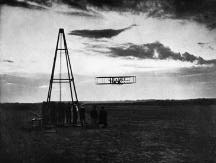 Camp d'Auvours, September 21, 1908: Wilbur's record flight of 1 hr 31 min 25 4/5 sec. Later that year he flew 2 hrs 19 min.
Click:
larger (double-width) picture.
| |
|
Click:
larger (65% wider) picture.
|
Click:
larger (40% wider) picture.
|
May 30, 1912
This morning at 3:15, Wilbur
passed away, aged 45 years, 1 month, and 14 days. A short life, full of
consequences. An unfailing intellect, imperturbable temper, great
self-reliance and as great modesty, seeing the right clearly, pursuing
it steadily, he lived and died.
- from the Diary of Bishop Milton Wright
Biography highlights
Wilbur Wright
1867, Apr. 16: Born, Millville, Ind.
1889: Began publication of a four-page weekly newspaper, the West Side News
1892-1904: Operated a bicycle repair shop and factory
1896-1903: Made aerial experiments with kites and gliders
1899: Built a model biplane which he flew as a kite
1900: Made first trip to Kitty Hawk, N.C., for experimental flights
1901: Built wind tunnel for testing wing surfaces
1903, Dec. 17: Participated with Orville in the first successful flight of a motor-powered airplane
1908: Made record-breaking flights near Le Mans, France, and concluded an agreement with a French syndicate for construction of flying machines in France
1909: Made round trip demonstration flights from Governors Island, N.Y., to the Statue of Liberty and Grant's Tomb.
With Orville organized the American Wright Co.
1912 May 30: Died, Dayton, Ohio
1867, Apr. 16: Born, Millville, Ind.
1889: Began publication of a four-page weekly newspaper, the West Side News
1892-1904: Operated a bicycle repair shop and factory
1896-1903: Made aerial experiments with kites and gliders
1899: Built a model biplane which he flew as a kite
1900: Made first trip to Kitty Hawk, N.C., for experimental flights
1901: Built wind tunnel for testing wing surfaces
1903, Dec. 17: Participated with Orville in the first successful flight of a motor-powered airplane
1908: Made record-breaking flights near Le Mans, France, and concluded an agreement with a French syndicate for construction of flying machines in France
1909: Made round trip demonstration flights from Governors Island, N.Y., to the Statue of Liberty and Grant's Tomb.
With Orville organized the American Wright Co.
1912 May 30: Died, Dayton, Ohio
Wright Brothers
Art Poster
National Archive
Art Poster
National Archive
Orville Wright
1871 Aug. 19: Born Dayton, Ohio
1889: Edited the West Side News
1892-1904: Operated a bicycle repair shop and factory
1896-1903: Made aerial experiments with kites and gliders
1900: Made first trip to Kitty Hawk, N.C., for experimental flights
1903, Dec. 17: Made first successful flight in a motor-powered airplane
1906: Received patent for the Wright flying machine
1908: Was seriously injured in airplane crash during demonstration flights for U.S. War Department
1909: Successfully completed airplane tests for the War Department.
Organized the American Wright Co.
1910: Formed first of the Wright exhibition teams of pilots trained to demonstrate the Wright airplane
1915: Sold his interest in the American Wright Co.
Became Director of the Wright Aeronautical Laboratory in Dayton, Ohio.
Appointed member of the U.S. Naval Consulting Board
1920: Appointed member of the National Advisory Committee for Aeronautics
1948, Jan. 30: Died, Dayton, Ohio
1871 Aug. 19: Born Dayton, Ohio
1889: Edited the West Side News
1892-1904: Operated a bicycle repair shop and factory
1896-1903: Made aerial experiments with kites and gliders
1900: Made first trip to Kitty Hawk, N.C., for experimental flights
1903, Dec. 17: Made first successful flight in a motor-powered airplane
1906: Received patent for the Wright flying machine
1908: Was seriously injured in airplane crash during demonstration flights for U.S. War Department
1909: Successfully completed airplane tests for the War Department.
Organized the American Wright Co.
1910: Formed first of the Wright exhibition teams of pilots trained to demonstrate the Wright airplane
1915: Sold his interest in the American Wright Co.
Became Director of the Wright Aeronautical Laboratory in Dayton, Ohio.
Appointed member of the U.S. Naval Consulting Board
1920: Appointed member of the National Advisory Committee for Aeronautics
1948, Jan. 30: Died, Dayton, Ohio
Source: http://www.wright-house.com/wright-brothers/Wrights.html
![[picture of Orville Wright's famous first airplane flight, 1903]](http://www.wright-house.com/wright-brothers/wrights/photos/1903-flight-wright-airplane.gif)
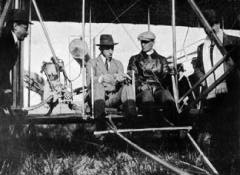
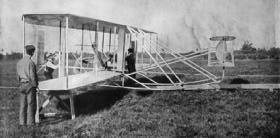
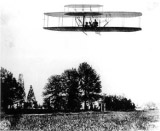
No comments:
Post a Comment